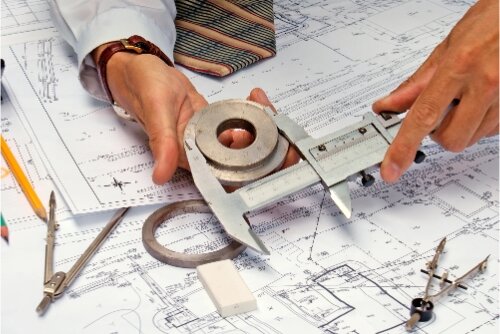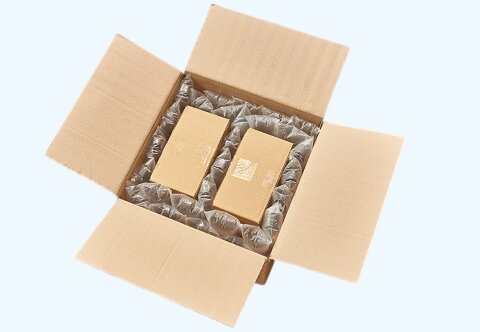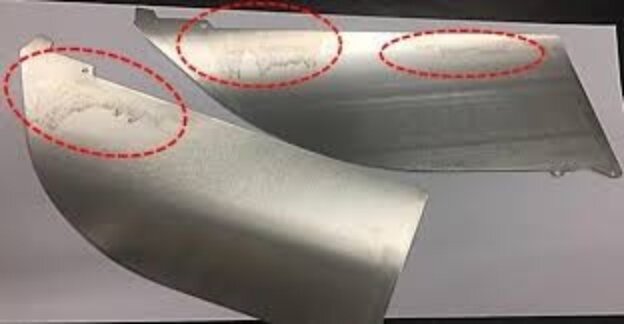Metallteile sind ständig von Rost und Korrosion bedroht, was zu kostspieligen Ersatzbeschaffungen und Wartungsarbeiten führt. Herkömmliche Schutzbeschichtungen sind oft unzureichend, da sie sich schnell abnutzen oder nur eine unzureichende Abdeckung bieten. Die Dacromet-Beschichtung löst diese Herausforderungen mit ihrer einzigartigen Zink-Aluminium-Formulierung und bietet einen hervorragenden Schutz für verschiedene industrielle Anwendungen.
Möchten Sie erfahren, wie diese fortschrittliche Beschichtungstechnologie die Lebensdauer Ihrer Teile verlängern und die langfristigen Wartungskosten senken kann? Lassen Sie uns die technischen Details, Vorteile und besten Anwendungen der Dacromet-Beschichtung untersuchen.
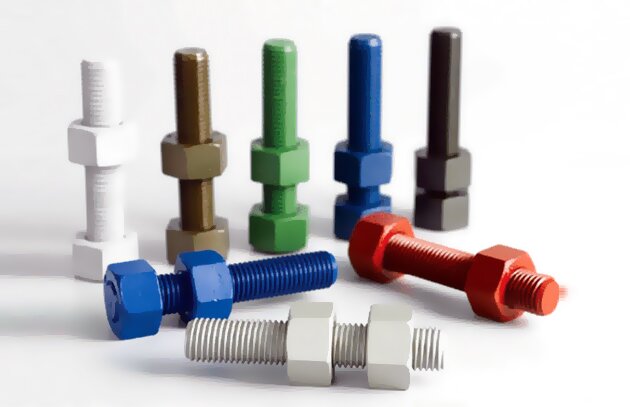
Was ist eine Dacromet-Beschichtung?
Die Dacromet-Beschichtung kombiniert Zinkflocken, Aluminiumpulver und anorganische Verbindungen in einer Lösung auf Wasserbasis. Dieses fortschrittliche Beschichtungssystem bildet eine mehrschichtige Barriere durch ein präzises Tauch-Spin-Auftragsverfahren, gefolgt von einer Aushärtung bei hoher Temperatur.
Stellen Sie sich vor, Sie bauen einen Schutzschild für Metalloberflächen - aber einen, der intelligenter ist als herkömmliche Beschichtungen. Das Verfahren beginnt mit dem Eintauchen der Teile in die Beschichtungsmischung, dem Schleudern, um eine gleichmäßige Abdeckung zu gewährleisten, und dem anschließenden Aushärten bei etwa 300 °C. So entsteht eine etwa 7-8 μm dicke Schutzschicht.
Zinkpartikel fungieren als Opferwächter, die die korrosiven Elemente abfangen, bevor sie das Grundmetall erreichen. In der Zwischenzeit bilden Aluminiumflocken eine physikalische Barriere, und das anorganische Bindemittel fixiert alles und kontrolliert gleichzeitig die Opferwirkung des Zinks.
Arten der Dacromet-Beschichtung
Verschiedene Anwendungen erfordern unterschiedliche Schutzniveaus und spezifische Leistungsmerkmale. Die Hersteller bieten verschiedene Varianten der Dacromet-Beschichtung an, die jeweils für bestimmte Anwendungen und Umweltbedingungen entwickelt wurden.
Der Basislack ist die Grundlage, die aus Zink-Aluminium-Flocken besteht, die mit speziellen Bindemitteln gemischt werden, um eine silberfarbene Schutzschicht zu bilden. Diese Basisformel bildet die Grundlage für weitere Spezialbeschichtungen.
Hier ist eine Aufschlüsselung der wichtigsten Arten:
Reihe Dacromet:
- 310/320: Perfekt für Befestigungsmaterial und Federnunter Verwendung einer auf sechswertigem Chrom basierenden Formulierung
- 500: Selbstschmierende Eigenschaften, ideal für Automobil- und Windenergiekomponenten
Serie Geomet (chromfrei):
- 720: Entwickelt für Befestigungselemente und Kfz-Teile, mit silikatbasierter Technologie
- 321: Bietet zuverlässigen Schutz für Anwendungen in der Bau- und Automobilindustrie
- 500: Enthält selbstschmierende Eigenschaften für geringere Reibung
- 320/360: Enthält einen höheren Aluminiumanteil für bessere Hitzebeständigkeit, speziell für Bremskomponenten entwickelt
Das Dacromet-Beschichtungsverfahren
Die Umwandlung von rohen Metallteilen in korrosionsbeständige Komponenten erfordert eine präzise Kontrolle und spezielle Ausrüstung. Ein erfolgreicher Beschichtungsprozess erfordert eine sorgfältige Beachtung von Materialien, Anwendungsmethoden und Qualitätskontrollmaßnahmen.
Für die Dacromet-Beschichtung verwendete Materialien
Die Auswahl geeigneter Materialien ist entscheidend für die Herstellung einer wirksamen Dacromet-Beschichtung. Jede Komponente spielt eine bestimmte Rolle in der endgültigen Schutzschicht.
Zu den wichtigsten Materialien gehören:
- Zinkflocken: Primärer Korrosionsinhibitor
- Aluminiumpulver: Verbessert die Barriereeigenschaften
- Anorganische Bindemittel: Sichern Metallpartikel an Ort und Stelle
- Spezialisierte Zusatzstoffe: Kontrolle von Viskosität und Fließverhalten
- Träger auf Wasserbasis: Ermöglichen eine gleichmäßige Verteilung
Schritt-für-Schritt-Verfahren für die Dacromet-Beschichtung
Der Beschichtungsprozess läuft in einer genauen Reihenfolge ab:
Vorbereitung der Oberfläche
- Teile gründlich reinigen, um Öle und Verunreinigungen zu entfernen
- Strahlen oder chemische Behandlung von Oberflächen für optimale Haftung
- Prüfen der Teile auf Sauberkeit und Oberflächenprofil
Anwendung der Beschichtung
- Teile in Dacromet-Lösung tauchen
- Schleudern mit kontrollierter Geschwindigkeit für eine gleichmäßige Abdeckung
- Erlauben Sie eine erste Lufttrocknung unter kontrollierten Bedingungen
Heilungsprozess
- Erhitzen der Teile auf etwa 300°C
- Aufrechterhaltung der Temperatur für eine bestimmte Dauer
- Kühlung unter kontrollierten Bedingungen
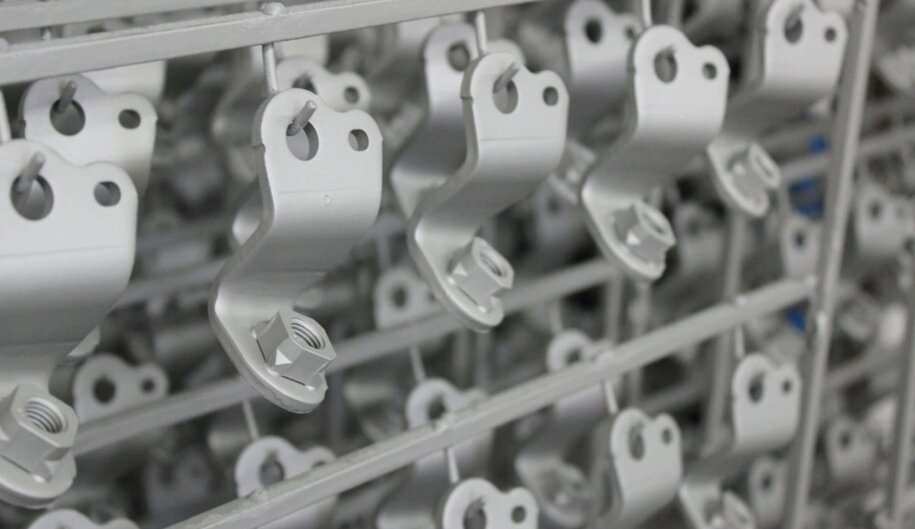
Vorteile der Dacromet-Beschichtung
Die Metallschutztechnologie entwickelt sich ständig weiter, und die Dacromet-Beschichtung zeichnet sich durch ihre umfassenden Vorteile aus. In diesem Abschnitt werden die wichtigsten Vorteile aufgezeigt, die Dacromet zu einer bevorzugten Wahl für den Metallschutz in verschiedenen Branchen machen.
Verbesserte Korrosionsbeständigkeit
Die Dacromet-Beschichtung schafft durch ihre einzigartige Schichtstruktur mehrere Barrieren gegen korrosive Elemente. Die Zink-Aluminium-Flocken bilden ein undurchdringliches Schild, das das Eindringen von Feuchtigkeit, Salz und Chemikalien verhindert.
Wichtige Schutzfunktionen:
- Hält mehr als 1.000 Stunden Salzsprühnebeltests stand
- Verhindert die Bildung von Rotrost
- Widersteht der chemischen Belastung in industriellen Umgebungen
Erhöhte Haltbarkeit und Langlebigkeit
Die mehrschichtige Struktur der Dacromet-Beschichtung verlängert die Lebensdauer der Komponenten erheblich. Diese Haltbarkeit führt zu einer geringeren Austauschhäufigkeit und niedrigeren Wartungskosten.
Leistungsmetriken:
- 20+ Jahre Lebensdauer unter normalen Bedingungen
- Hohe Verschleißfestigkeit
- Starke Haftung auf unedlen Metallen
Widerstandsfähigkeit gegen hohe Temperaturen
Dacromet behält seine Schutzeigenschaften über einen breiten Temperaturbereich bei. Dank dieser Hitzestabilität eignet es sich für Bauteile, die Temperaturschwankungen ausgesetzt sind.
Temperaturverhalten:
- Stabil bis zu 300°C (572°F)
- Keine Erweichung oder Rissbildung bei Hitze
- Behält die Haftung bei Temperaturschwankungen bei
Umweltfreundliche Aspekte der Dacromet-Beschichtung
Das Beschichtungsverfahren entspricht den modernen Umweltstandards. Die Formulierung auf Wasserbasis und die Produktionsmethoden reduzieren die ökologischen Auswirkungen.
Grüne Vorteile:
- Keine VOC-Emissionen
- REACH- und RoHS-konform
- Recycelbare beschichtete Teile
Geringe Wartungsanforderungen
Einmal aufgetragen, erfordert die Dacromet-Beschichtung nur minimale Pflege. Die selbstheilenden Eigenschaften des Zinks bieten dauerhaften Schutz ohne regelmäßige Wartung.
Vorteile bei der Wartung:
- Es ist kein regelmäßiger Neuanstrich erforderlich
- Selbstreparierende kleine Kratzer
- Behält sein Aussehen über die Zeit bei
Nachteile der Dacromet-Beschichtung
Begrenzte ästhetische Anziehungskraft
Die Beschichtung ergibt eine graue, matte Oberfläche, die nicht für alle Anwendungen geeignet ist. Im Vergleich zu anderen Beschichtungsarten sind die Farboptionen begrenzt.
Anfälligkeit für mechanische Beschädigungen
Trotz ihrer schützenden Eigenschaften kann die Dacromet-Beschichtung durch starke Stöße oder Abrieb beschädigt werden. Auch scharfe Gegenstände oder schwere Lasten können die Integrität der Beschichtung beeinträchtigen.
Längere Aushärtungszeit im Vergleich zu anderen Beschichtungen
Der mehrschichtige Applikationsprozess erfordert spezielle Aushärtungsbedingungen und -zeiten. Dadurch verlängern sich die Produktionszeitpläne im Vergleich zu einfacheren Beschichtungsmethoden.
Potenzial für uneinheitliche Beschichtungsdicken
Die Applikationstechnik beeinflusst die Gleichmäßigkeit der Beschichtung. Komplexe Teilegeometrien können zu Dickenschwankungen führen, die sich auf das Schutzniveau auswirken.
Höhere Kosten für die Erstanwendung
Die für die Dacromet-Beschichtung erforderlichen speziellen Anlagen und die Prozesssteuerung führen zu höheren Anfangskosten. Diese Anfangsinvestition muss gegen die langfristigen Vorteile abgewogen werden.
Anwendungen der Dacromet-Beschichtung
Dacromet-Beschichtungen werden in zahlreichen Branchen eingesetzt, in denen der Schutz von Metallen gegen raue Umgebungsbedingungen von entscheidender Bedeutung ist. Diese vielseitige Beschichtungslösung erfüllt spezifische Leistungsanforderungen in verschiedenen Sektoren, von der Automobilindustrie bis hin zu Schiffsanwendungen.
Anwendungen in der Automobilindustrie
Die Automobilbranche verlässt sich in hohem Maße auf die Dacromet-Beschichtung, um kritische Komponenten vor Streusalz, Feuchtigkeit und Umwelteinflüssen zu schützen. Diese Beschichtung hilft den Herstellern, strenge Haltbarkeitsstandards zu erfüllen und gleichzeitig Garantieansprüche zu reduzieren.
Gängige Anwendungen im Automobilbereich:
- Komponenten des Bremssystems
- Teile der Aufhängung
- Fahrgestellbefestigungen
- Motorhalterungen
- Komponenten des Kraftstoffsystems
Luft- und Raumfahrt und militärische Anwendungen
In der Luft- und Raumfahrt und im Verteidigungsbereich erfüllt die Dacromet-Beschichtung strenge Leistungsanforderungen. Die Beschichtung schützt Komponenten, die extremen Bedingungen und unterschiedlichen Klimabedingungen ausgesetzt sind.
Wichtige Anwendungen im Militär und in der Luft- und Raumfahrt:
- Strukturelle Verbindungselemente
- Fahrwerkskomponenten
- Externe Hardware
- Ausrüstung für die Bodenunterstützung
- Halterungen
Bau- und Infrastrukturprojekte
Die Bauindustrie schätzt die Dacromet-Beschichtung für ihren langfristigen Schutz von Bauteilen. Diese Beschichtung trägt zur Verlängerung der Lebensdauer von Infrastrukturen in schwierigen Umgebungen bei.
Die Anwendungen im Bauwesen umfassen:
- Komponenten der Brücke
- Leitplanken für Autobahnen
- Befestigungselemente für den Bau
- Unterstützungsstrukturen
- Dehnungsfugen
Marine Anwendungen
Meeresumgebungen erfordern einen hervorragenden Korrosionsschutz. Die Dacromet-Beschichtung bietet hervorragende Beständigkeit gegen Salzsprühnebel und ständige Feuchtigkeit.
Der Marinesektor verwendet:
- Hardware an Deck
- Hafenausrüstung
- Offshore-Plattformen
- Schiffsausrüstung
- Container-Komponenten
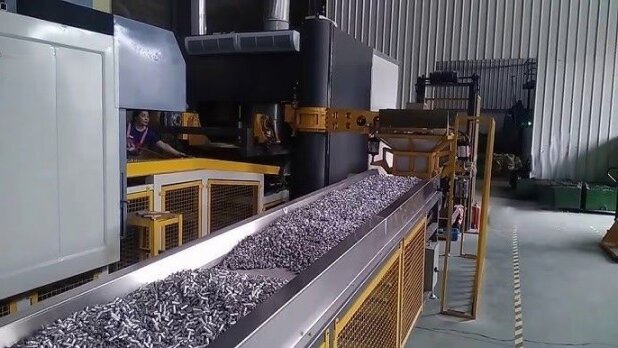
Dacromet-Beschichtung vs. Verzinkung
Die richtige Wahl zwischen den Beschichtungsoptionen wirkt sich sowohl auf die Leistung als auch auf die Kosten aus. Dieser Vergleich hilft Entscheidungsträgern bei der Auswahl der am besten geeigneten Lösung für ihre spezifischen Anforderungen.
Kritische Unterschiede in der Korrosionsbeständigkeit
Die beiden Beschichtungsmethoden bieten unterschiedliche Schutzniveaus gegen korrosive Umgebungen. Tests zeigen deutliche Leistungsunterschiede unter schwierigen Bedingungen.
Vergleich der Korrosionsbeständigkeit:
- Dacromet: 1.000+ Stunden Beständigkeit gegen Salzsprühnebel
- Verzinkung: 200-300 Stunden Salzsprühnebelbeständigkeit
Schutzmechanismen:
- Dacromet schafft mehrere Barriereschichten
- Verzinkung beruht auf einem Opferschutz
- Risiken für Basismetalle unterscheiden sich erheblich
Kosten-Wirksamkeit
Die anfänglichen Kosten und der langfristige Wert stellen für jeden Beschichtungstyp unterschiedliche wirtschaftliche Szenarien dar. Eine gründliche Analyse zeigt die wahren Kostenauswirkungen im Laufe der Zeit.
Zu berücksichtigende Kostenfaktoren:
Dacromet:
- Höhere Vorabinvestitionen
- Niedrigere Wartungskosten
- Verlängerte Nutzungsdauer
Verzinkung:
- Niedrigere Anfangskosten
- Ein häufigeres Nachstreichen ist erforderlich
- Höhere langfristige Kosten
Langlebigkeit und Leistung im Vergleich
Die Leistung dieser Beschichtungsoptionen unterscheidet sich in der Praxis erheblich. Umweltbedingungen und Anwendungsanforderungen beeinflussen die Langlebigkeit der Beschichtung.
Leistungsmetriken:
Temperaturbeständigkeit:
- Dacromet: Bis zu 300°C
- Verzinkung: Bis zu 120°C
Konsistenz der Dicke:
- Dacromet: Gleichmäßige Abdeckung
- Verzinkung: Variabler Aufbau
Schlagfestigkeit:
- Dacromet: Mäßige Flexibilität
- Verzinkung: Brüchiger
Chemische Beständigkeit:
- Dacromet: Hochwiderstandsfähig
- Verzinkung: Mäßiger Widerstand
Schlussfolgerung
Die Dacromet-Beschichtung beweist ihren Wert durch hervorragenden Korrosionsschutz und langfristige Kostenvorteile. Die Anfangsinvestition mag zwar höher sein, aber die verlängerte Lebensdauer und der geringere Wartungsaufwand machen sie zu einer intelligenten Wahl für anspruchsvolle Anwendungen. Die Umweltverträglichkeit der Beschichtung und ihre bewährte Erfolgsbilanz in verschiedenen Branchen machen sie zu einer zuverlässigen Lösung für die Herausforderungen der modernen Fertigung.
Über die Dacromet-Beschichtung hinaus bieten wir umfassende kundenspezifische Fertigungslösungen für alle Ihre Anforderungen. Mit fortschrittlicher Ausrüstung und einem professionellen technischen Team können wir Ihre vielfältigen Anforderungen erfüllen in CNC-Bearbeitung, Blechfertigungund mehr. Wählen Sie uns, um Ihren Fertigungsprozess effizienter und nahtloser zu gestalten.
FAQs
Wie lange hält die Dacromet-Beschichtung?
Unter normalen Bedingungen hält die Dacromet-Beschichtung in der Regel 20-25 Jahre. Die tatsächliche Lebensdauer hängt von der Umwelteinwirkung und den Anwendungsbedingungen ab. Regelmäßige Inspektionen helfen, die Leistung der Beschichtung im Laufe der Zeit zu überwachen.
Kann Dacromet Coating auf alle Materialien aufgetragen werden?
Die Dacromet-Beschichtung funktioniert am besten auf Stahl- und Eisensubstraten. Sie kann zwar auch auf andere Metalle aufgetragen werden, doch erfordert der Beschichtungsprozess besondere Oberflächenbedingungen und Vorbereitungsmethoden, um eine ordnungsgemäße Haftung zu gewährleisten.
Ist die Dacromet-Beschichtung umweltverträglich?
Die wasserbasierte Formulierung enthält keine Schwermetalle oder schädlichen Lösungsmittel. Die Dacromet-Beschichtung erfüllt die weltweit geltenden Umweltvorschriften, einschließlich der REACH- und RoHS-Normen. Bei dem Verfahren entstehen nur minimale Abfälle und Emissionen.
Enthält Dacromet hexavalentes Chrom?
Nein, die Dacromet-Beschichtung ist frei von sechswertigem Chrom. Stattdessen werden dreiwertige Chromverbindungen verwendet, wodurch sie den modernen Umwelt- und Sicherheitsstandards entspricht.
Wie dick ist die Beschichtung von Dacromet?
Die Standarddicke der Dacromet-Beschichtung reicht von 5 bis 15 Mikrometer. Die genaue Dicke hängt von den Anforderungen der Anwendung und der spezifizierten Qualitätsstufe ab. Qualitätskontrollmaßnahmen gewährleisten eine gleichbleibende Schichtdicke bei allen Teilen.
Hey, ich bin Kevin Lee

In den letzten 10 Jahren bin ich in verschiedene Formen der Blechbearbeitung eingetaucht und teile hier coole Erkenntnisse aus meinen Erfahrungen in verschiedenen Werkstätten.
Kontakt aufnehmen

Kevin Lee
Ich verfüge über mehr als zehn Jahre Berufserfahrung in der Blechverarbeitung und bin auf Laserschneiden, Biegen, Schweißen und Oberflächenbehandlungstechniken spezialisiert. Als Technischer Direktor bei Shengen bin ich bestrebt, komplexe Fertigungsherausforderungen zu lösen und Innovation und Qualität in jedem Projekt voranzutreiben.


